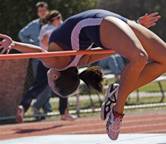Extreme
Skydiving

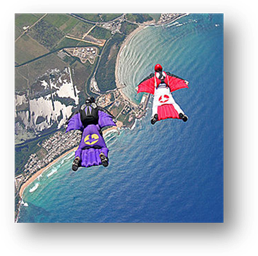
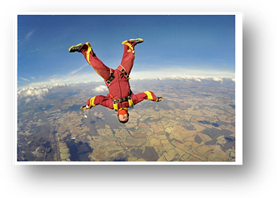
Unit
Overview
In this unit you will be introduced to the outrages
outdoor extreme sports of Wingsuit
skydiving, Freeflying
and Skysurfing. These extreme sports came from the sports of
skydiving and BASE jumping. Wingsuit flying
is where participates wear a special suit that enables the human body to glide
through the air. It is almost like a
human hang glider. A Wingsuit is also known as a birdman suit or a flying
squirrel suit. The sport of Freeflying is a form of skydiving that began in
1990’s when Olav Zipser started experimenting with non-traditional forms of
body flight while free falling. Skysurfing
is a cross between surfing and skydiving.
The skydiver wears a board attached to his or her feet and performs
surfing type aerobatics during free fall.
You will also be learning about muscular strength and muscular
endurance. Muscular
endurance is the
ability to use the voluntary muscles many times without getting tired. Muscular strength is the ability to use
the voluntary muscles many times without getting tired.
Wingsuit
Skydiving
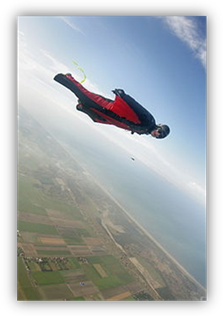
Wingsuiting is an exciting extreme sport that
combines skydiving and BASE jumping. Like
both of these activities, wingsuit flying requires the flyer to either jump out
of an aircraft or off a fixed object to achieve a high enough altitude. Wingsuit
skydivers use the suit in conjunction with a skydiving or BASE jumping
parachute system. While hang gliders can coast in for a safe landing, wingsuit
flyers have to deploy their parachutes and float the rest of the way to the
ground. Wingsuit skydiving uses a
specially designed suit with arm and leg wings.
A skilled wingsuit pilot can cover great horizontal distances experiencing
the effect of true flight.
Wingsuit pilots are unable to reduce their speed
fast enough for a safe landing without the use of a parachute. However, until they pull their parachute,
participates can soar horizontally at high speeds while performing aerial
acrobatics. A wingsuit can add a level of difficulty to a parachute or a BASE
jump. Therefore it is recommended
jumpers are experienced by requiring a minimum of 200 skydives before their
first wingsuit jump. Today there are many designs for different levels of
experiences for the wingsuit pilot.
The early Wingsuits were made of canvas, wood, silk,
steel, and other types of material and they were considered very unreliable. It is recorded that between 1930 and 1961, 72
of the 75 original wingsuit pilots died testing their wingsuits. Because of the
high fatality rate, the United States Parachute Association (UPAP) banned the
use of wingsuits.
In the late 1980’s Christoh Aarns made great strides
in wingsuit design. His design added
stability to the suit and because of these advancements, the UAPA lifted its
ban on wingsuit skydiving.
The mid 1990’s took the wingsuit concept further
with French skydiver Patrick De Gayardon’s design which made the wing surface
greater between the legs and under the arms of the suit. He later died while testing this concept,
but De Gayardon’s design went on to become the basis for modern wingsuit technology.
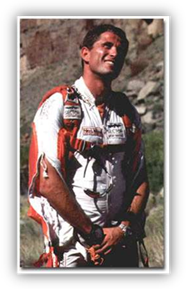
Patrick De Gayardon
The first commercially available wingsuits were sold
in 1998. Since then the sport has grown
with two wingsuit manufactures currently offering a wide range of designs.
How
does a windsuit work?
The wing suit works because of the basic concepts of
flight. They are weight, lift, thrust and drag.
Weight pulls the object that
is flying down, lift happens when
the downward momentum of the object meets the resistance of the air. An example of this would be sticking your
hand out of a moving vehicle. The force
resistance you feel is the motion of the air opposing the motion of your
hand. If you make your hand a flat
surface or airfoil, then this slows down the rate of the object dropping and it
moves the object upward at the same time.
Weight and lift cover the vertical motion (up and down) of an
object. Thrust and drag cover horizontal
movement (flat, level) of an object. The
average skydiver moves towards the earth at a rate 120 miles per hour (mph) and
can soar horizontally at 30 to 60 mph.
An average wingsuit pilot can fall at a rate of 50 to 60 mph and can
reach horizontal speeds of 70 to 90 mph. That is why windsuit skydiving is considered
one of the most extreme sports of our time.
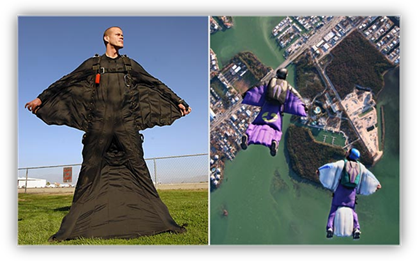
Wingsuit
Training
Wingsuit skydiving is a very difficult task. The United States Parachute Association
requires that any skydiver using a wingsuit for the first time must have the
completed the following requirements:
è A
minimum of 200 freefall skydives made within the past 18 months.
è Receive
one-on-one instruction from an experienced wingsuit skydiver.
-OR-
è A
minimum of 500 freefall jumps to go without an instructor.
Most Wingsuit manufactures, offer training courses
and they also certify instructors.
Freeflying
Freeflying
is considered a skydiving discipline which began in 1990 when Olav Zipser began
experimenting with non-traditional forms of body flight. Freeflying includes
the traditional belly-to-earth positions of freefalling. Freeflyers also extend into vertical flight
where the flyer is in an upright position (falling feet first) or in an
inverted position (falling head first). These positions increase freefall
speeds so that new formations and routines are made possible. Freeflyers maneuver
into different body positions which are primarily in vertical body positions.
The basic positions are sitting, standing and head down. When head down in
freefall, the human body can attain a high rate of speed.
A freeflyer must have a great understanding
of the aerodynamics of the human body in freefall. The first thing a freeflyer
needs to learn is to control in all of the traditional freefall positions.
Traditional Freefall Positions:
Ø The Box Position- the Belly is pointed to the earth.
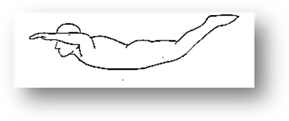
Ø The Back Flying Position-the back is pointed to the earth.
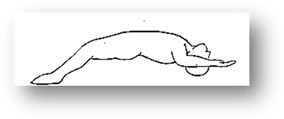
Ø The Head–up Flying Position- this is like standing up while freefalling
feet pointed to the earth.
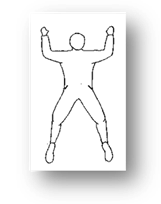
Ø The Head-down Flying Position-this is like standing on your
head while freefalling, head pointed to the earth.
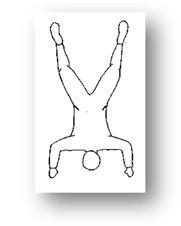
Ø The Side Flying Position-this is like being on your side
while freefalling, side pointed to the earth
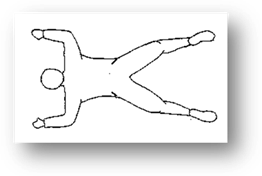
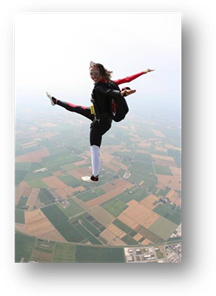
These positions are not held for the
entire skydive. Freeflying involves a constant transition in position and
speed. This involves a continuously flowing skydive, with all positions
explored. A more static position is used when skydivers are concentrating on
building large formations.
Freeflying is extremely dangerous
due to the increase in freefall speeds and potentially faster horizontal
speeds. Freeflying has dangers way
beyond a normal skydiving. While freeflying is a younger and more extreme
addition to skydiving, it is becoming a popular event in competitions and world
records.
Skysurfing
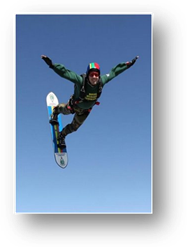
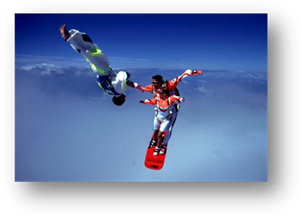
Skysufing is a team parachute sport. The team consists of a Skysurfer and a Camera
flyer. The Skysurfer rides on a specially designed
skyboard during freefall, sliding, spinning, twisting and surfing through the
sky. The Cameraflyer records the
performance with a camcorder mounted on his or her helmet. The Cameraflyer also contributes to the
performance by interacting with the skysurfer’s performance. When a skysurfer
is filmed by another skydiver falling alongside them, the resulting film gives
the appearance that the skysurfer is riding on the air in the same way a surfer
rides on a wave. The downward motion is not very apparent and this creates the
illusion that a skysurfer is gliding on air currents like a sailplane or hang
glider. In fact a skysurfer always falls at a high speed comparable to any
other freefalling parachutist.
The boards that are used for skysurfing look like a
snowboard or a large skateboard. The
skysurfer’s feet are attached to the board and is easily removable in case the
performer loses control or has difficulty opening his or her parachute.
Comparing Skysurfing to other board sports is a
common mistake. The only thing
Skysurfing and skate boarding or snowboarding have in common is that they all
involve some type of board. Skysurfing
is much more related to freestyle skydiving. Both sports perform
gymnastic/ballet-style maneuvers utilizing aerodynamics during freefall. However, adding a board to the equation makes
it an entirely new sport.
Skysurfing requires a considerable amount of
practice. The most basic skill is to
stand upright on the board during freefall and tilt the nose of the board
downward to generate forward movement. This basic maneuver requires plenty of
balance which experience skydivers find very difficult to perform. The extra drag of the board upsets the
balance and makes the skysurfer flip over.
More advanced maneuvers such as loops, rolls and helicopter spins, are
more difficult and are usually mastered after the basics are learned.
The
Invention of Skysurfing
Skysurfing was invented by two French skydivers Dominique Jacquet and Jean-Pascal Oron in 1986. It did not become popular until the 1990’s thanks to the efforts of the late skydiver Patrick De Gayardon. De Gayardon was famous for his unique style of skysurfing because he pushed the boundaries of skydiving. His was also known for the development of the modern Wingsuit.
Because of the possibility of dropping the board,
not every skydiving club permits skysurfing.
Only a minority of skydivers have attempted this recent specialization
in the sport of Skysurfing. Like all
forms of extreme skydiving, skysurfing is considered extremely dangerous and
should only be performed by experts and skydivers who have great amount of practice.
Skysurfing
videos:
Muscular Strength and Muscular
Endurance

![MPj04243570000[1]](HEALTHPEIIU12Extreme_Skydiving_image037.jpg)

Muscular
Strength
Muscular strength is the ability of the muscles to exert force like
weight lifting the heaviest weight you can manage.
The Three Different Types of Muscular
Strength
|
Static
Strength |
Static
strength is the strength needed to push or pull a very heavy object or to
hold a very heavy object or weight above your head. Examples:
power weight lifters and Sumo wrestlers |
|
|
|
|
Dynamic
Strength |
Dynamic
strength is the strength needed to keep a load moving over a long period of
time. Examples:
rowing and swimming |
|
|
|
|
Explosive
Strength |
Explosive
strength is the strength needed for a single explosive act. Examples: the
high jump, shot put, hitting a baseball |
|
|
|
Muscular strength
is improved by using heavy weights and doing a few repetitions. It is very
important that, before starting any weight lifting program, you seek the advice
of an expert in this type of physical exercise. Do not attempt a weight lifting
program by yourself. If you do not know how to properly
start a weight program you could do more harm than good. You should always have someone to help with
the weights and to spot you during your weight lifting routine. Before buying a
set of weights, you should go to a gym and try the equipment to make sure that
this is the kind of program you want to start.
Muscular Endurance
Muscular endurance is the ability to use the voluntary muscles many
times without getting tired. The best way to improve muscular endurance is to
use circuit training. Circuit
Training is a series of exercise
machines set up in sequence. The exercises are performed one after the other,
each stressing a different muscle group.

When doing muscular strength and
muscular endurance exercises, always make sure that you are using the correct
form. Doing excessive repetitions or lifting more weight does not make you
stronger sooner. Trying to do too much when performing strengthening exercises
can increase your risk of injury. Always pay attention to your body and its
safety. It is best to seek the advice of a weight lifting expert before you
start any weight lifting program.
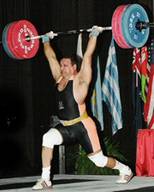
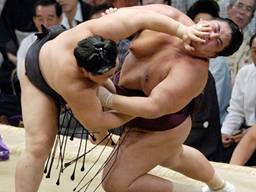
![MPj04067770000[1]](HEALTHPEIIU12Extreme_Skydiving_image045.jpg)
![MPj04117150000[1]](HEALTHPEIIU12Extreme_Skydiving_image047.jpg)
![MPj04243570000[1]](HEALTHPEIIU12Extreme_Skydiving_image049.jpg)
![MPj03849260000[1]](HEALTHPEIIU12Extreme_Skydiving_image051.jpg)

![MPj04286240000[1]](HEALTHPEIIU12Extreme_Skydiving_image054.jpg)
